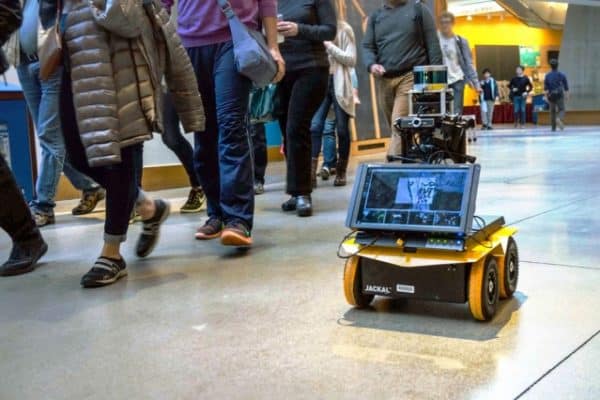
 Sidewalk etiquette. Many people can’t, seemingly, figure out a few simple rules. But now robots can.
Sidewalk etiquette. Many people can’t, seemingly, figure out a few simple rules. But now robots can.
Engineers at MIT have designed a pedestrian-friendly robot that can deftly navigate areas with busy foot traffic.
We’ve all, quite literally, run into people who seem oblivious to the rules of pedestrian behaviour. But being unwritten doesn’t make them any less real —or vital, for that matter, to safe and efficient movement within crowded urban areas.
Walk to the right, no abrupt stopping, share the road/sidewalk, keep up a reasonable pace and, for pete’s sake, get your head out of your phone!
Walk to the right, no abrupt stopping, share the road/sidewalk, keep up a reasonable pace and, for pete’s sake, get your head out of your phone. How hard is that?
Not too difficult, you might say, but less easy to program into a robot, something that’s becoming a real live concern as mobile robotic devices become more commonplace within our everyday human spaces.
“Socially aware navigation is a central capability for mobile robots operating in environments that require frequent interactions with pedestrians,” says Yu Fan “Steven” Chen, former MIT graduate student and lead author of a new study demonstrating their autonomous robot, in a press release.
“For instance, small robots could operate on sidewalks for package and food delivery,” says Chen. “Similarly, personal mobility devices could transport people in large, crowded spaces, such as shopping malls, airports, and hospitals.”
To that end, Chen and colleagues focused on four aspects of pedestrian activity: localization, recognizing one’s surroundings, choosing the optimal path to reach your destination and, lastly, physically getting where you want to go.
And while figuring out its surroundings is pretty simple stuff for a robot kitted up with a slew of webcams, depth sensors and lidar sensors (radar which use laser light instead of radio waves), the route-planning element proved to be trickier, most notably because pedestrian traffic is a fluid, forever changing dynamic.
“The knock on robots in real situations is that they might be too cautious or aggressive,” says MIT graduate student Michal Everett, study co-author. “People don’t find them to fit into the socially accepted rules, like giving people enough space or driving at acceptable speeds, and they get more in the way than they help.”
Thus, the researchers spent time using AI reinforcement learning to bring their robot up to speed -basically, getting their robot to perform in simulation over and over so as to teach it the rules that apply in real world contexts.
Their work proved a success, as displayed by a 20-minute autonomous test-drive the robot took around the corridors of an MIT building with busy circulation, done with zero collisions or mishaps.
“Crowds have a different dynamic than individual people, and you may have to learn something totally different if you see five people walking together,” Everett says. “There may be a social rule of, ‘Don’t move through people, don’t split people up, treat them as one mass.’ That’s something we’re looking at in the future.”
Meanwhile, up in Saskatoon, another robot is being put to use, this one you’re actually supposed to run into. It’s a remote-controlled tackling dummy, a new technology that football teams in the NFL and NCAA in the US have taken a fancy to. This time, it’s teams like the Saskatoon Hilltops and Saskatoon Valkyries that will be trying to knock the block off an MVP Drive (Mobile Virtual Player).
“[Football’s] a great game,” says David Dubé, who donated the MVP Drive to Football Saskatchewan, to CBC News. “But it’s a violent game, and if you can practise and learn how to hit properly on this guy, it will be a lot safer to play the game.”
Of course, for those who absolutely cannot learn a little bit of sidewalk etiquette, there is this example in Washington, DC. It’s a cell phone lane for pedestrians.
Leave a Reply
You must be logged in to post a comment.




 Share
Share Tweet
Tweet Share
Share




Comment